Apps
Auto Added by WPeMatico
Auto Added by WPeMatico
Since Jour, a new app for private and portable journaling, dropped on the App Store two months ago, it’s racked up 80,000 users. No paid marketing or public announcements. Just organic interest in discovering a better way of journaling than pen to paper.
“We can reinvent and redesign what we call journaling and the journal,” Jour co-founder and chief executive officer Maxime Germain told TechCrunch. “If we do it right, it will go mainstream.”
New York-based Jour has raised a $1.8 million seed round from True Ventures’ Kevin Rose. Similar to the meditation apps that have skyrocketed in popularity recently, Jour’s guided sequences are meant to facilitate the journaling process and encourage writers to mindfully reflect and record their lives. With its seed funding, Jour will create a library of audio sessions and written questions meant to spark inspiration.
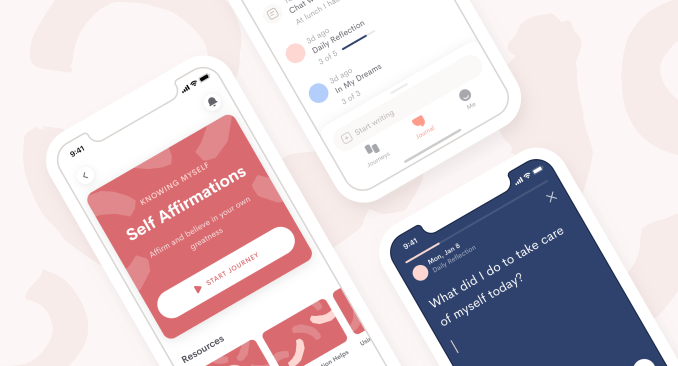
“Meditation apps have shown there are some self-care habits we can use in our life to feel better, to feel less anxious,” Germain, a French native who relocated to New York seven years ago, said. “But the journal is a way to capture moments and people’s authentic selves. It’s all the stuff you might not be sharing on social media.”
Jour, at its core, is an app battling mental illness. The business joins a number of other well-being apps and venture-backed startups targeting the mental health crisis. From brick-and-mortar therapy clinics to chat apps to emotional wellness assistants, venture capitalists are waking up to the emotional struggles rampant across the globe.
“Ten years ago when I first started using meditation apps I think there was a certain type of stigma; like you need help so you’re meditating,” True Venture’s Rose, a founder of Digg, Oak, a guided meditation app, and Zero, an app for tracking intermittent fasting, told TechCrunch. “Now, it’s just crossed over to the mainstream.”
“I’m hopeful we are finally getting to a point where we can have open conversations about mental health,” Rose added.
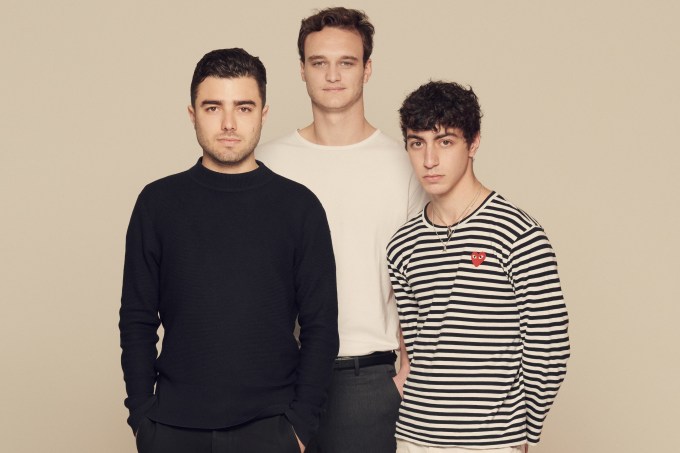
Jour co-founders (from left to right) Maxime Germain, Justin Bureau and Bobby Giangeruso
As Jour deals with an influx of new users, it’s keeping the entire app and all of its features free, though eventually, the team plans to add a paywall to some of the guided content. As for anyone concerned about the safety of your anxieties, hopes and dreams, Jour’s founding team, which includes Germain, Bobby Giangeruso and Justin Bureau, built the app with zero-knowledge encryption.
“I would feel very uncomfortable if the rest of the people on my team could read my most intimate thoughts,” Germain explained. “We built [Jour] with an encryption key that stays on the phone, all the data is encrypted with that key and if you lose that key we can’t recover the entries that we save on the servers. Only you have access to that key, it’s stored on the phone, it encrypts the data and even if the data is compromised we can’t get it.”
Phew. The last thing we need today is our diaries getting hacked.
Powered by WPeMatico
One of the bigger developments in customer services has been the impact of social media — both as a place to vent frustration or praise (mostly frustration) and — especially over messaging apps — as a place for businesses to connect with their users.
Now, customer support specialist Zendesk has made an acquisition so that it can make a bigger move into how it works within social media platforms, and specifically messaging apps: it has acquired Smooch, a startup that describes itself as an “omnichannel messaging platform,” which companies’ customer care teams can use to interact with people over messaging platforms like WhatsApp, WeChat, Line and Messenger, as well as SMS and email.
Smooch was in fact one of the first partners for the WhatsApp Business API, alongside VoiceSage, Nexmo, Infobip, Twilio, MessageBird and others already advertising their services in this area.
It had also been a longtime partner of Zendesk’s, powering the company’s own WhatsApp Business integration and other features. The two already have some customers in common, including Uber. Other Smooch customers include Four Seasons, SXSW, Betterment, Clarabridge, Harry’s, LVMH, Delivery Hero and BarkBox.
Terms of the deal are not being disclosed, but Zendesk SVP class=”il”>Shawna Wolverton said in an interview that the startup’s entire team of 48, led by co-founder and CEO Warren Levitan, are being offered positions with Zendesk. Smooch is based out of Montreal, Canada — so this represents an expansion for Zendesk into building an office in Canada.
Its backers included iNovia, TA Associates and Real Ventures, who collectively had backed it with less than $10 million (when you leave the inflated hills surrounding Silicon Valley, numbers magically decline). As Zendesk is publicly traded, we may get more of a picture of the price in future quarterly reports. This is the company’s fifth acquisition to date.
The deal underscores the big impact that messaging apps are making in customer service. While phone and internet are massive points of contact, messaging apps is one of the most-requested features Zendesk’s customers are requesting, “because they want to be where their customers are,” with WhatsApp — now at 1.5 billion users — currently at the top of the pile, Wolverton said. (More than half of Zendesk’s revenues are from outside the U.S., which speaks to why WhatsApp — which is bigger outside the U..S than it is in it — is a popular request.)
That’s partly a by-product of how popular messaging apps are full-stop, with more than 75% of all smartphone users having at least one messaging app in use on their devices.
“We live in a messaging-centric world, and customers expect the convenience and interactivity of messaging to be part of their experiences,” said Mikkel Svane, Zendesk founder, CEO and chairman, in a statement. “As long-time partners with Smooch, we know first hand how much they have advanced the conversational experience to bring together all forms of messaging and create a continuous conversation between customers and businesses.”
While the two companies were already working together, the acquisition will mean a closer integration.
That will be in multiple areas. Last year, Zendesk launched a new CRM play called Sunshine, going head to head with the likes of Salesforce in helping businesses better organise and make use of customer data. Smooch will build on that strategy to bring in data to Sunshine from messaging apps and the interactions that take place on them. Also last year, Zendesk launched an omnichannel play, a platform called The Suite, which it says “has become one of our most successful products ever,” with a 400% rise in its customers taking an omnichannel approach. Smooch already forms a key part of that, and it will be even more tightly so.
On the outbound side, for now, there will be two areas where Smooch will be used, Wolverton said. First will be on the basic level of giving Zendesk users the ability to see and create messaging app discussions within a dashboard where they are able to monitor and handle all customer relationship contacts: a conversation that was initiated now on, say, Twitter, can be easily moved into WhatsApp or whatever more direct channel someone wants to use.
Second, Wolverton said that customer care workers can use Smooch to send on “micro apps” to users to handle routine service enquiries, for example sending them links to make or change seat assignments on a flight.
Over time, the plan will be to bring more automated options into the experience, which opens the door for using more AI and potentially bots down the line.
Powered by WPeMatico
What’s the cord-cutting equivalent to ditching your kitchen? Uber’s upcoming subscription to unlimited free food delivery. Uber is preparing to launch the $9.99 per month Uber Eats Pass, according to code hidden in Uber’s Android app.
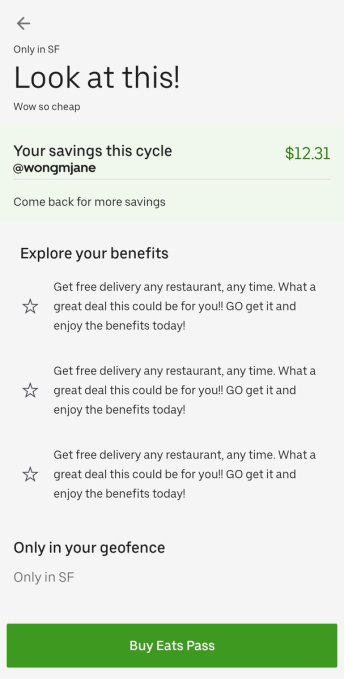 The subscription would waive Uber’s service fee that’s typically 15% of your order cost. Given that’s often $5 or more, users stand to save a lot if they order in frequently. But Uber could still earn money on menu item markups, cover costs with a flat order fee that protects against someone ordering a single taco, and, most importantly, build loyalty and scale at a time of intense food delivery competition.
The subscription would waive Uber’s service fee that’s typically 15% of your order cost. Given that’s often $5 or more, users stand to save a lot if they order in frequently. But Uber could still earn money on menu item markups, cover costs with a flat order fee that protects against someone ordering a single taco, and, most importantly, build loyalty and scale at a time of intense food delivery competition.
The Uber Eats Pass was first spotted by Jane Manchun Wong, the notorious reverse-engineering specialist who’s become a frequent TechCrunch tipster. She managed to generate screenshots from Uber’s Android app code that reveals a prototype of the feature. “Get free delivery, any restaurant, any time,” it says, showing the amount of money you could save or already saved.
An Uber spokesperson did not dispute the legitimacy of the findings and told TechCrunch, “We’re always thinking about new ways to enhance the Eats experience.” They declined to provide further details, which could hint that a launch is imminent but some details are still subject to change. For now we don’t know exactly which perks come with an Eats Pass or where it will be launching first.
At $9.99 per month, the Uber Eats Pass would cost the same and work similarly to Postmates Unlimited and DoorDash DashPass. If they all seem like good deals, you see why they’re less about immediate revenue and more about customer lock-in. You’re a lot less likely to order GrubHub or Caviar if you’ve already pre-paid to cover your Uber Eats delivery costs. And whichever apps emerge from this battle will have instituted the scale and steady behavior to raise prices or just enjoy large lifetime value from each subscriber.
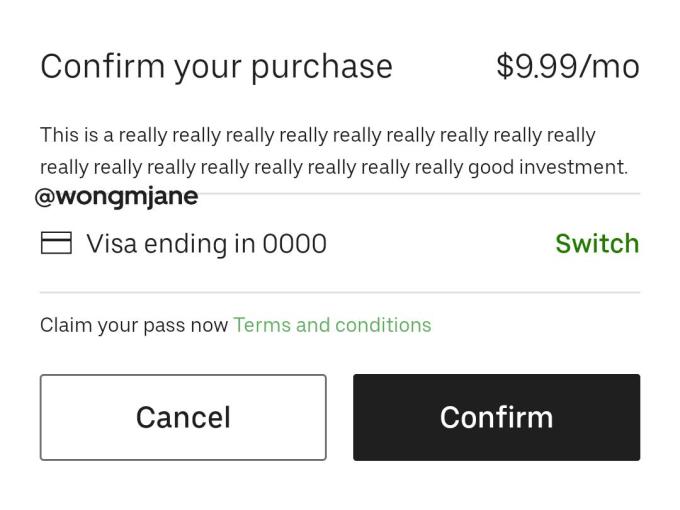
Exploring new business opportunities could help perk up Uber’s share price, which closed at $41.50 today, two weeks after IPOing at an opening price of $42. There are fears that intense competition across both ridesharing and food delivery could make for an expensive road ahead for the newly public company. Any way it can gain an edge on its rivals’ users from straying to them is important. The logistics giant is already experimenting with allowing restaurants to offer discounts in exchange for promoted placement in the app, which is the first step to Uber becoming an ads company, where businesses pay for extra exposure.
If Uber combined Eats Pass with its car service subscription Ride Passes, you have the foundation for a sort of Uber Prime experience — one where you pay an upfront subscription fee that scores you perks and discounts but also makes you likely to spend a lot more on Uber. That bundle could be even more central to Uber than Amazon, which has few direct rivals in the west. People will need to eat and get around for the foreseeable future. Subsidizing loyalty now could be costly in the short-term, but poise Uber for years of lucrative business down the line.
Powered by WPeMatico
DefinedCrowd, the Startup Battlefield alumnus that produces and refines data for AI-training purposes, has just debuted iOS and Android apps for its army of human annotators. It should help speed up a process that the company already touts as one of the fastest in the industry.
It’s no secret that AI relies almost totally on data that has been hand-annotated by humans, pointing out objects in photos, analyzing the meaning of sentences or expressions and so on. Doing this work has become a sort of cottage industry, with many annotators doing it part time or between other jobs.
There’s a limit, however, to what you can do if the interface you must use to do it is only available on certain platforms. Just as others occasionally answer an email or look over a presentation while riding the bus or getting lunch, it’s nice to be able to do work on mobile — essential, really, at this point.
 To that end, DefinedCrowd has made its own app, which shares the Neevo branding of the company’s annotation community, that lets its annotators work whenever they want, tackling image or speech annotation tasks on the go. It’s available on iOS and Android starting today.
To that end, DefinedCrowd has made its own app, which shares the Neevo branding of the company’s annotation community, that lets its annotators work whenever they want, tackling image or speech annotation tasks on the go. It’s available on iOS and Android starting today.
It’s a natural evolution of the market, CEO Daniela Braga told me. There’s a huge demand for this kind of annotation work, and it makes no sense to restrict the schedules or platforms of the people doing it. She suggested everyone in the annotation space would have apps soon, just as every productivity or messaging service does. And why not?
The company is growing quickly, going from a handful of employees to over a hundred, spread over its offices in Lisbon, Porto, Seattle and Tokyo. The market, likewise, is exploding as more and more companies find that AI is not just applicable to what they do, but is not out of their reach.
Powered by WPeMatico
Does the overcrowded and cut-throat music streaming business have room for an additional player? The world’s most valuable startup certainly thinks so.
Chinese conglomerate ByteDance, valued at more than $75 billion, is working on a music streaming service, two sources familiar with the matter told TechCrunch. The company, which operates popular app TikTok, has held discussions with music labels in recent months to launch the app as soon as the end of this quarter, one of the sources said.
The app will offer both a premium and an ad-supported free tier, one of the sources said. Bloomberg, which first wrote about the premium app, reported that ByteDance is targeting emerging markets with its new music app. A ByteDance spokesperson declined to comment.
For ByteDance, interest in a music app does not come as a surprise. Snippets of pop songs from movies and albums intertwined with videos shot by its humongous user base is part of the service’s charm. The company already works with music labels worldwide to licence usage of their tracks on its platform. In China, where ByteDance claims to have tie-ups with more than 800 labels, it has been aggressively expanding efforts to find music talents and urge them to make their own tracks.
Besides, ByteDance has been expanding its app portfolio in recent months. Earlier this year, the company released Duoshan, a video chat app that appears to be a mix of TikTok and Snap. This week, it launched Feiliao, another chat app that is largely focused on text-driven conversations. At some point, the company may have realized the need for a standalone music consumption app.
When asked about TikTok’s partnership with music labels last month, Todd Schefflin, TikTok’s head of global music business development, told WSJ that music is part of the app’s “creative DNA” but it is “ultimately for short video creation and viewing, not a product for music consumption.”
The private Chinese company is likely eyeing India as a key market for its music app. The company has been in discussion with local music labels T Series and Times Music for rights. Moreover, its apps are estimated to have more than 300 million monthly active users in the nation, though there could be significant overlaps among them.
India may have also inspired ByteDance to consider a free, ad-supported version of its music app. Even as more than 150 million users in India listen to music online, only a tiny portion of this user base is willing to pay for it.
This has made India a unique battleground for local and international music giants, most of which offer an ad-supported, free version of their apps in the market. Even premium offerings from Apple and Spotify cost less than $1.2 a month. India is the only market where Spotify offers a free version of its app that has access to the entire catalog on demand.
The launch of the app could put the spotlight again on ByteDance in India, where its TikTok app recently landed in hot water. An Indian court banned the app for roughly a week after expressing concerns over questionable content on the platform. Ever since the nation lifted the ban on TikTok, the company has become visibly cautious about its movement.
Powered by WPeMatico
Instagram conquered Stories, but it’s losing the battle for the next video formats. TikTok is blowing up with an algorithmically suggested vertical one-at-a-time feed featuring videos of users remixing each other’s clips. Snapchat Discover’s 2 x infinity grid has grown into a canvas for multi-media magazines, themed video collections and premium mobile TV shows.
Instagram’s IGTV…feels like a flop in comparison. Launched a year ago, it’s full of crudely cropped and imported viral trash from around the web. The long-form video hub that lives inside both a homescreen button in Instagram as well as a standalone app has failed to host lengthier must-see original vertical content. Sensor Tower estimates that the IGTV app has just 4.2 million installs worldwide, with just 7,700 new ones per day — implying less than half a percent of Instagram’s billion-plus users have downloaded it. IGTV doesn’t rank on the overall charts and hangs low at No. 191 on the US – Photo & Video app charts, according to App Annie.

Now Instagram has quietly overhauled the design of IGTV’s space inside its main app to crib what’s working from its two top competitors. The new design showed up in last week’s announcements for Instagram Explore’s new Shopping and IGTV discovery experiences. At the time, Instagram’s product lead on Explore Will Ruben told us that with the redesign, “the idea is this is more immersive and helps you to see the breadth of videos in IGTV rather than the horizontal scrolling interface that used to exist,” but the company declined to answer follow-up questions about it.
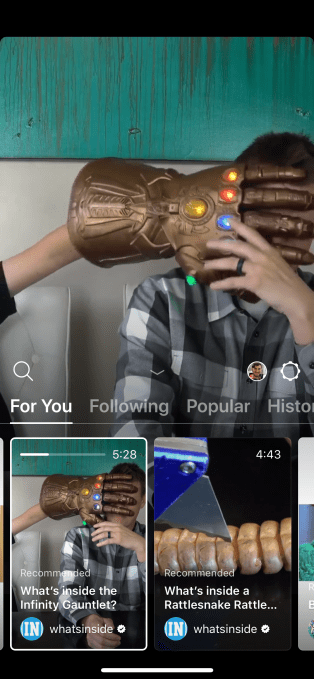 IGTV has ditched its category-based navigation system’s tabs like “For You”, “Following”, “Popular”, and “Continue Watching” for just one central feed of algorithmically suggested videos — much like TikTok. This affords a more lean-back, ‘just show me something fun’ experience that relies on Instagram’s AI to analyze your behavior and recommend content instead of putting the burden of choice on the viewer.
IGTV has ditched its category-based navigation system’s tabs like “For You”, “Following”, “Popular”, and “Continue Watching” for just one central feed of algorithmically suggested videos — much like TikTok. This affords a more lean-back, ‘just show me something fun’ experience that relies on Instagram’s AI to analyze your behavior and recommend content instead of putting the burden of choice on the viewer.
IGTV has also ditched its awkward horizontal scrolling design that always kept a clip playing in the top half of the screen. Now you’ll scroll vertically through a 2 x infinity grid of recommended clips in what looks just like a Snapchat Discover feed. Once you get past a first video that auto-plays up top, you’ll find a full-screen grid of things to watch. You’ll only see the horizontal scroller in the standalone IGTV app, or if you tap into an IGTV video, and then tap the Browse button for finding a next clip while the last one plays up top.
Instagram seems to be trying to straddle the designs of its two competitors. The problem is that TikTok’s one-at-a-time feed works great for punchy, short videos that get right to the point. If you’re bored after five seconds you swipe to the next. IGTV’s focus on long-form means its videos might start too slowly to grab your attention if they were auto-played full-screen in the feed rather than being chosen by a viewer. But Snapchat makes the most of the two previews per row design IGTV has adopted because professional publishers take the time to make compelling cover thumbnail images promoting their content. IGTV’s focus on independent creators means fewer have labored to make great cover images, so viewers have to rely on a screenshot and caption.
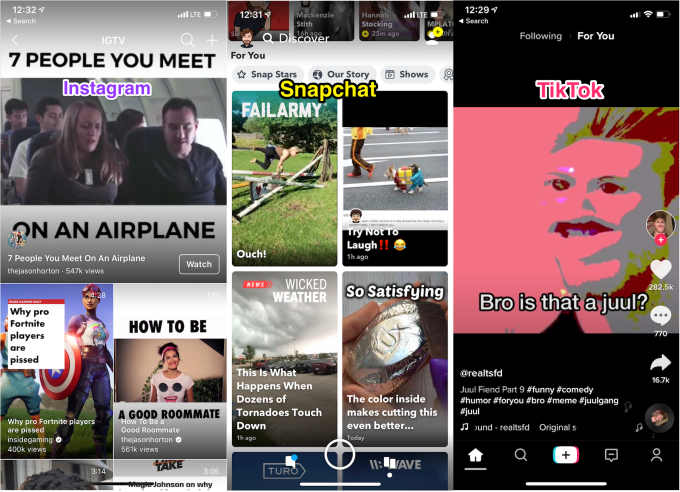
Instagram is prototyping a number of other features to boost engagement across its app, as discovered by reverse-engineering specialist and frequent TechCrunch tipster Jane Manchun Wong. Those include options to blast a direct message to all your Close Friends at once but in individual message threads, see a divider between notifications and likes you have or haven’t seen, or post a Chat sticker to Stories that lets friends join a group message thread about that content. And to better compete with TikTok, it may let you add lyrics stickers to Stories that appear word-by-word in sync with Instagram’s licensed music soundtrack feature, and share Music Stories to Facebook. What we haven’t seen is any cropping tool for IGTV that would help users reformat landscape videos. The vertical-only restriction keeps lots of great content stuck outside IGTV, or letterboxed with black, color-matched backgrounds, or meme-style captions with the video as just a tiny slice in the middle.
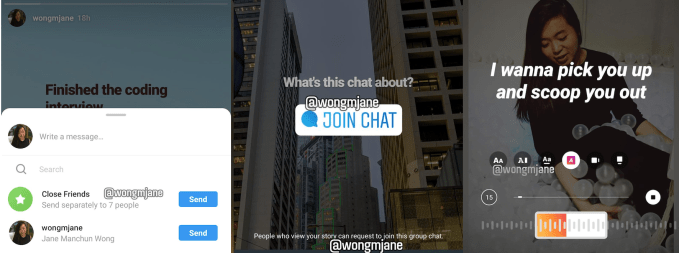
When I spoke with Instagram co-founder and ex-CEO Kevin Systrom last year a few months after IGTV’s launch, he told me, “It’s a new format. It’s different. We have to wait for people to adopt it and that takes time . . . Everything that is great starts small.”
But to grow large, IGTV needs to demonstrate how long-form portrait mode video can give us a deeper look at the nuances of the influencers and topics we care about. The company has rightfully prioritized other drives like safety and well-being with features that hide bullies and deter overuse. But my advice from August still stands despite all the ground Instagram has lost in the meantime. “Concentrate on teaching creators how to find what works on the format and incentivizing them with cash and traffic. Develop some must-see IGTV and stoke a viral blockbuster. Prove the gravity of extended, personality-driven vertical video.” Until the content is right, it won’t matter how IGTV surfaces it.
Powered by WPeMatico
The Trump administration Huawei ban is sure to have wide-ranging and long lasting effects for all parties. In the meantime, it seems, a number of those involved in the periphery are treading lightly in hope of not burning bridges on either side. Google has taken accidental center stage, in its role providing Android and a variety of apps for the embattled handset maker.
According to a new report from Reuters, the U.S. software giant has taken some steps toward disentangling itself. Word comes from unnamed sources, who say the company has suspended all businesses with Huawei, aside from those covered by open-source licenses. The list appears to include updates to Android and popular apps like Gmail.
From the sound of it, Google is still attempting to wrap its head around how to proceed with the matter. Huawei, too, is assessing its options. Given the complexity of smartphone hardware and software, handsets routinely utilize components source from a variety of different locations. This fact has complicated things as trade tensions have begun to rise, hitting ZTE particularly hard over accusations that the company had violated U.S.-Iran sanctions.
Huawei has called the ban bad for all parties, but has continued to be defiant, noting its plans to become “self-reliant.” The company has no doubt been preparing for the seeming inevitability of heightened trade tensions, but its determination has some industry observers unconvinced that it can carry on with without any input from Google or U.S. chipmakers like Qualcomm.
Powered by WPeMatico
Extra Crunch offers members the opportunity to tune into conference calls led and moderated by the TechCrunch writers you read every day. This week, TechCrunch’s Kate Clark sat down with Eric Yuan, the founder and CEO of video communications startup Zoom, to go behind the curtain on the company’s recent IPO process and its path to the public markets.
Since hitting the trading desks just a few weeks ago, Zoom stock is up over 30%. But the Zoom’s path to becoming a Silicon Valley and Wall Street darling was anything but easy. Eric tells Kate how the company’s early focus on profitability, which is now helping drive the stock’s strong performance out of the gate, actually made it difficult to get VC money early on, and the company’s consistent focus on user experience led to organic growth across different customer bases.
Eric: I experienced the year 2000 dot com crash and the 2008 financial crisis, and it almost wiped out the company. I only got seed money from my friends, and also one or two VCs like AME Cloud Ventures and Qualcomm Ventures.
nd all other institutional VCs had no interest to invest in us. I was very paranoid and always thought “wow, we are not going to survive next week because we cannot raise the capital. And on the way, I thought we have to look into our own destiny. We wanted to be cash flow positive. We wanted to be profitable.
nd so by doing that, people thought I wasn’t as wise, because we’d probably be sacrificing growth, right? And a lot of other companies, they did very well and were not profitable because they focused on growth. And in the future they could be very, very profitable.

Eric and Kate also dive deeper into Zoom’s founding and Eric’s initial decision to leave WebEx to work on a better video communication solution. Eric also offers his take on what the future of video conferencing may look like in the next five to 10 years and gives advice to founders looking to build the next great company.
For access to the full transcription and the call audio, and for the opportunity to participate in future conference calls, become a member of Extra Crunch. Learn more and try it for free.
Kate Clark: Well thanks for joining us Eric.
Eric Yuan: No problem, no problem.
Kate: Super excited to chat about Zoom’s historic IPO. Before we jump into questions, I’m just going to review some of the key events leading up to the IPO, just to give some context to any of the listeners on the call.
Powered by WPeMatico
When your game tops 100 million players, your thoughts naturally turn to doubling that number. That’s the case with the creators, or rather stewards, of Minecraft at Microsoft, where the game has become a product category unto itself. And now it is making its biggest leap yet — to a real-world augmented reality game in the vein of Pokémon GO, called Minecraft Earth.
Announced today but not playable until summer (on iOS and Android) or later, MCE (as I’ll call it) is full-on Minecraft, reimagined to be mobile and AR-first. So what is it? As executive producer Jesse Merriam put it succinctly: “Everywhere you go, you see Minecraft. And everywhere you go, you can play Minecraft.”
Yes, yes — but what is it? Less succinctly put, MCE is like other real-world-based AR games in that it lets you travel around a virtual version of your area, collecting items and participating in mini-games. Where it’s unlike other such games is that it’s built on top of Minecraft: Bedrock Edition, meaning it’s not some offshoot or mobile cash-in; this is straight-up Minecraft, with all the blocks, monsters and redstone switches you desire, but in AR format. You collect stuff so you can build with it and share your tiny, blocky worlds with friends.
That introduces some fun opportunities and a few non-trivial limitations. Let’s run down what MCE looks like — verbally, at least, as Microsoft is being exceedingly stingy with real in-game assets.
Because it’s Minecraft Earth, you’ll inhabit a special Minecraftified version of the real world, just as Pokémon GO and Harry Potter: Wizards Unite put a layer atop existing streets and landmarks.
The look is blocky to be sure, but not so far off the normal look that you won’t recognize it. It uses OpenStreetMaps data, including annotated and inferred information about districts, private property, safe and unsafe places and so on — which will be important later.
The fantasy map is filled with things to tap on, unsurprisingly called tappables. These can be a number of things: resources in the form of treasure chests, mobs and adventures.
Chests are filled with blocks, naturally, adding to your reserves of cobblestone, brick and so on, all the different varieties appearing with appropriate rarity.
 Mobs are animals like those you might normally run across in the Minecraft wilderness: pigs, chickens, squid and so on. You snag them like items, and they too have rarities, and not just cosmetic ones. The team highlighted a favorite of theirs, the muddy pig, which when placed down will stop at nothing to get to mud and never wants to leave, or a cave chicken that lays mushrooms instead of eggs. Yes, you can breed them.
Mobs are animals like those you might normally run across in the Minecraft wilderness: pigs, chickens, squid and so on. You snag them like items, and they too have rarities, and not just cosmetic ones. The team highlighted a favorite of theirs, the muddy pig, which when placed down will stop at nothing to get to mud and never wants to leave, or a cave chicken that lays mushrooms instead of eggs. Yes, you can breed them.
Last are adventures, which are tiny AR instances that let you collect a resource, fight some monsters and so on. For example you might find a crack in the ground that, when mined, vomits forth a volume of lava you’ll have to get away from, and then inside the resulting cave are some skeletons guarding a treasure chest. The team said they’re designing a huge number of these encounters.
Importantly, all these things — chests, mobs and encounters — are shared between friends. If I see a chest, you see a chest — and the chest will have the same items. And in an AR encounter, all nearby players are brought in, and can contribute and collect the reward in shared fashion.
And it’s in these AR experiences and the “build plates” you’re doing it all for that the game really shines.
“If you want to play Minecraft Earth without AR, you have to turn it off,” said Torfi Olafsson, the game’s director. This is not AR-optional, as with Niantic’s games. This is AR-native, and for good and ill the only way you can really play is by using your phone as a window into another world. Fortunately it works really well.
First, though, let me explain the whole build plate thing. You may have been wondering how these collectibles and mini-games amount to Minecraft. They don’t — they’re just the raw materials for it.
Whenever you feel like it, you can bring out what the team calls a build plate, which is a special item, a flat square that you virtually put down somewhere in the real world — on a surface like the table or floor, for instance — and it transforms into a small, but totally functional, Minecraft world.
In this little world you can build whatever you want, or dig into the ground, build an inverted palace for your cave chickens or create a paradise for your mud-loving pigs — whatever you want. Like Minecraft itself, each build plate is completely open-ended. Well, perhaps that’s the wrong phrase — they’re actually quite closely bounded, as the world only exists out to the edge of the plate. But they’re certainly yours to play with however you want.
Notably all the usual Minecraft rules are present — this isn’t Minecraft Lite, just a small game world. Water and lava flow how they should, blocks have all the qualities they should and mobs all act as they normally would.
The magic part comes when you find that you can instantly convert your build plate from miniature to life-size. Now the castle you’ve been building on the table is three stories tall in the park. Your pigs regard you silently as you walk through the halls and admire the care and attention to detail with which you no doubt assembled them. It really is a trip.
In the demo, I played with a few other members of the press; we got to experience a couple of build plates and adventures at life-size (technically actually 3/4 life size — the 1 block to 1 meter scale turned out to be a little daunting in testing). It was absolute chaos, really, everyone placing blocks and destroying them and flooding the area and putting down chickens. But it totally worked.
The system uses Microsoft’s new Azure Spatial Anchor system, which quickly and continuously fixed our locations in virtual space. It updated remarkably quickly, with no lag, showing the location and orientation of the other players in real time. Meanwhile the game world itself was rock-solid in space, smooth to enter and explore, and rarely bugging out (and that only in understandable circumstances). That’s great news considering how heavily the game leans on the multiplayer experience.
The team said they’d tested up to 10 players at once in an AR instance, and while there’s technically no limit, there’s sort of a physical limit in how many people can fit in the small space allocated to an adventure or around a tabletop. Don’t expect any giant 64-player raids, but do expect to take down hordes of spiders with three or four friends.
In choosing to make the game the way they’ve made it, the team naturally created certain limitations and risks. You Wouldn’t want, for example, an adventure icon to pop up in the middle of the highway.
For exactly that reason the team spent a lot of work making the map metadata extremely robust. Adventures won’t spawn in areas like private residences or yards, though of course simple collectibles might. But because you’re able to reach things up to 70 meters away, it’s unlikely you’ll have to knock on someone’s door and say there’s a cave chicken in their pool and you’d like to touch it, please.
Furthermore adventures will not spawn in areas like streets or difficult to reach areas. The team said they worked very hard making it possible for the engine to recognize places that are not only publicly accessible, but safe and easy to access. Think sidewalks and parks.
Another limitation is that, as an AR game, you move around the real world. But in Minecraft, verticality is an important part of the gameplay. Unfortunately, the simple truth is that in the real world you can’t climb virtual stairs or descend into a virtual cave. You as a player exist on a 2D plane, and can interact with but not visit places above and below that plane. (An exception of course is on a build plate, where in miniature you can fly around it freely by moving your phone.)
That’s a shame for people who can’t move around easily, though you can pick up and rotate the build plate to access different sides. Weapons and tools also have infinite range, eliminating a potential barrier to fun and accessibility.
In Pokémon GO, there’s the drive to catch ’em all. In Wizards Unite, you’ll want to advance the story and your skills. What’s the draw with Minecraft Earth? Well, what’s the draw in Minecraft? You can build stuff. And now you can build stuff in AR on your phone.
The game isn’t narrative-driven, and although there is some (unspecified) character progression, for the most part the focus is on just having fun doing and making stuff in Minecraft. Like a set of LEGO blocks, a build plate and your persistent inventory simply make for a lively sandbox.
Admittedly that doesn’t sound like it carries the same addictive draw of Pokémon, but the truth is Minecraft kind of breaks the rules like that. Millions of people play this game all the time just to make stuff and show that stuff to other people. Although you’ll be limited in how you can share to start, there will surely be ways to explore popular builds in the future.
And how will it make money? The team basically punted on that question — they’re fortunately in a position where they don’t have to worry about that yet. Minecraft is one of the biggest games of all time and a big money-maker — it’s probably worth the cost just to keep people engaged with the world and community.
MCE seems to me like a delightful thing, but one that must be appreciated on its own merits. A lack of screenshots and gameplay video isn’t doing a lot to help you here, I admit. Trust me when I say it looks great, plays well and seems fundamentally like a good time for all ages.
A few other stray facts I picked up:
Sound fun? Sign up for the beta here.
Powered by WPeMatico
Children with vision impairments struggle to get a solid K-12 education for a lot of reasons — so the more tools their teachers have to impart basic skills and concepts, the better. ObjectiveEd is a startup that aims to empower teachers and kids with a suite of learning games accessible to all vision levels, along with tools to track and promote progress.
Some of the reasons why vision-impaired kids don’t get the education they deserve are obvious, for example that reading and writing are slower and more difficult for them than for sighted kids. But other reasons are less obvious, for example that teachers have limited time and resources to dedicate to these special needs students when their overcrowded classrooms are already demanding more than they can provide.
Technology isn’t the solution, but it has to be part of the solution, because technology is so empowering and kids take to it naturally. There’s no reason a blind 8-year-old can’t also be a digital native like her peers, and that presents an opportunity for teachers and parents both.
This opportunity is being pursued by Marty Schultz, who has spent the last few years as head of a company that makes games targeted at the visually impaired audience, and in the process saw the potential for adapting that work for more directly educational purposes.
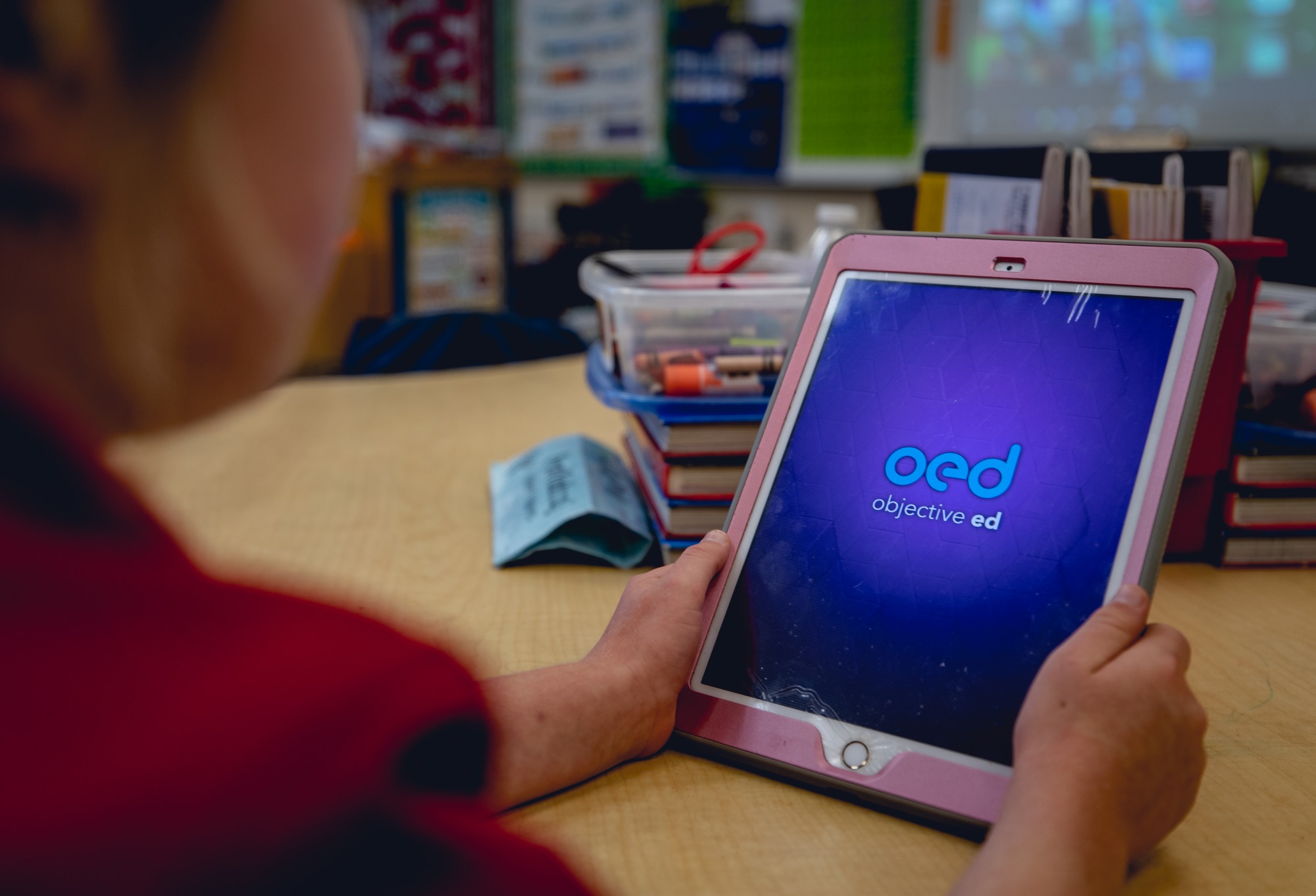 “Children don’t like studying and don’t like doing their homework,” he told me. “They just want to play video games.”
“Children don’t like studying and don’t like doing their homework,” he told me. “They just want to play video games.”
It’s hard to argue with that. True of many adults too, for that matter. But as Schultz points out, this is something educators have realized in recent years and turned to everyone’s benefit.
“Almost all regular education teachers use educational digital games in their classrooms and about 20% use it every day,” he explained. “Most teachers report an increase in student engagement when using educational video games. Gamification works because students own their learning. They have the freedom to fail, and try again, until they succeed. By doing this, students discover intrinsic motivation and learn without realizing it.”
Having learned to type, point and click, do geometry and identify countries via games, I’m a product of this same process, and many of you likely are as well. It’s a great way for kids to teach themselves. But how many of those games would be playable by a kid with vision impairment or blindness? Practically none.
It turns out that these kids, like others with disabilities, are frequently left behind as the rising technology tide lifts everyone else’s boats. The fact is it’s difficult and time-consuming to create accessible games that target things like Braille literacy and blind navigation of rooms and streets, so developers haven’t been able to do so profitably and teachers are left to themselves to figure out how to jury-rig existing resources or, more likely, fall back on tried and true methods like printed worksheets, in-person instruction and spoken testing.
And because teacher time is limited and instructors trained in vision-impaired learning are thin on the ground, these outdated methods are also difficult to cater to an individual student’s needs. For example a kid may be great at math but lack directionality skills. You need to draw up an “individual education plan” (IEP) explaining (among other things) this and what steps need to be taken to improve, then track those improvements. It’s time-consuming and hard! The idea behind ObjectiveEd is to create both games that teach these basic skills and a platform to track and document progress as well as adjust the lessons to the individual.
How this might work can be seen in a game like Barnyard, which like all of ObjectiveEd’s games has been designed to be playable by blind, low-vision or fully sighted kids. The game has the student finding an animal in a big pen, then dragging it in a specified direction. The easiest levels might be left and right, then move on to cardinal directions, then up to clock directions or even degrees.
“If the IEP objective is ‘Child will understand left versus right and succeed at performing this task 90% of the time,’ the teacher will first introduce these concepts and work with the child during their weekly session,” Schultz said. That’s the kind of hands-on instruction they already get. “The child plays Barnyard in school and at home, swiping left and right, winning points and getting encouragement, all week long. The dashboard shows how much time each child is playing, how often, and their level of success.”
That’s great for documentation for the mandated IEP paperwork, and difficulty can be changed on the fly as well:
“The teacher can set the game to get harder or faster automatically, or move onto the next level of complexity automatically (such as never repeating the prompt when the child hesitates). Or the teacher can maintain the child at the current level and advance the child when she thinks it’s appropriate.”
This isn’t meant to be a full-on K-12 education in a tablet app. But it helps close the gap between kids who can play Mavis Beacon or whatever on school computers and vision-impaired kids who can’t.
Importantly, the platform is not being developed without expert help — or, as is actually very important, without a business plan.
“We’ve developed relationships with several schools for the blind as well as leaders in the community to build educational games that tackle important skills,” Schultz said. “We work with both university researchers and experienced Teachers of Visually Impaired students, and Certified Orientation and Mobility specialists. We were surprised at how many different skills and curriculum subjects that teachers really need.”
Based on their suggestions, for instance, the company has built two games to teach iPhone gestures and the accessibility VoiceOver rotor. This may be a proprietary technology from Apple, but it’s something these kids need to know how to use, just like they need to know how to run a Google search, use a mouse without being able to see the screen, and other common computing tasks. Why not learn it in a game like the other stuff?
 Making technological advances is all well and good, but doing so while building a sustainable business is another thing many education startups have failed to address. Fortunately, public school systems actually have significant money set aside specifically for students with special needs, and products that improve education outcomes are actively sought and paid for. These state and federal funds can’t be siphoned off to use on the rest of the class, so if there’s nothing to spend them on, they go unused.
Making technological advances is all well and good, but doing so while building a sustainable business is another thing many education startups have failed to address. Fortunately, public school systems actually have significant money set aside specifically for students with special needs, and products that improve education outcomes are actively sought and paid for. These state and federal funds can’t be siphoned off to use on the rest of the class, so if there’s nothing to spend them on, they go unused.
ObjectiveEd has the benefit of being easily deployed without much specialty hardware or software. It runs on iPads, which are fairly common in schools and homes, and the dashboard is a simple web one. Although it may eventually interface with specialty hardware like Braille readers, it’s not necessary for many of the games and lessons, so that lowers the deployment bar as well.
The plan for now is to finalize and test the interface and build out the games library — ObjectiveEd isn’t quite ready to launch, but it’s important to build it with constant feedback from students, teachers and experts. With luck, in a year or two the visually-impaired youngsters at a school near you might have a fun new platform to learn and play with.
“ObjectiveEd exists to help teachers, parents and schools adapt to this new era of gamified learning for students with disabilities, starting with blind and visually impaired students,” Schultz said. “We firmly believe that well-designed software combined with ‘off-the-shelf’ technology makes all this possible. The low cost of technology has truly revolutionized the possibilities for improving education.”
Powered by WPeMatico